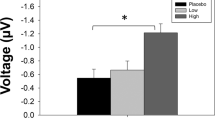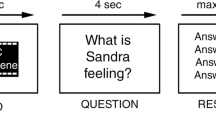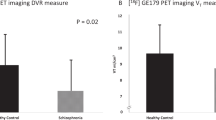Abstract
Psychotomimetics like the N-methyl-D-aspartate receptor (NMDAR) antagonist ketamine and the 5-hydroxytryptamine2A receptor (5-HT2AR) agonist psilocybin induce psychotic symptoms in healthy volunteers that resemble those of schizophrenia. Recent theories of psychosis posit that aberrant encoding of prediction errors (PE) may underlie the expression of psychotic symptoms. This study used a roving mismatch negativity (MMN) paradigm to investigate whether the encoding of PE is affected by pharmacological manipulation of NMDAR or 5-HT2AR, and whether the encoding of PE under placebo can be used to predict drug-induced symptoms. Using a double-blind within-subject placebo-controlled design, S-ketamine and psilocybin, respectively, were administrated to two groups of healthy subjects. Psychological alterations were assessed using a revised version of the Altered States of Consciousness (ASC-R) questionnaire. As an index of PE, we computed changes in MMN amplitudes as a function of the number of preceding standards (MMN memory trace effect) during a roving paradigm. S-ketamine, but not psilocybin, disrupted PE processing as expressed by a frontally disrupted MMN memory trace effect. Although both drugs produced positive-like symptoms, the extent of PE processing under placebo only correlated significantly with the severity of cognitive impairments induced by S-ketamine. Our results suggest that the NMDAR, but not the 5-HT2AR system, is implicated in PE processing during the MMN paradigm, and that aberrant PE signaling may contribute to the formation of cognitive impairments. The assessment of the MMN memory trace in schizophrenia may allow detecting early phases of the illness and might also serve to assess the efficacy of novel pharmacological treatments, in particular of cognitive impairments.
Similar content being viewed by others
Log in or create a free account to read this content
Gain free access to this article, as well as selected content from this journal and more on nature.com
or
References
Adler C, Malhotra A, Elman I, Goldberg T, Egan M, Pickar D et al (1999). Comparison of ketamine-induced thought disorder in healthy volunteers and thought disorder in schizophrenia. Am J Psychiatry 156: 1646–1649.
Alho K, Tervaniemi M, Huotilainen M, Lavikainen J, Tiitinen H, Ilmoniemi R et al (1996). Processing of complex sounds in the human auditory cortex as revealed by magnetic brain responses. Psychophysiology 33: 369–375.
Baldeweg T (2006). Repetition effects to sounds: evidence for predictive coding in the auditory system. Trends Cogn Sci 10: 93–94.
Baldeweg T, Klugman A, Gruzelier J, Hirsch S (2004). Mismatch negativity potentials and cognitive impairment in schizophrenia. Schizophr Res 69: 203–217.
Bodatsch M, Ruhrmann S, Wagner M, Müller R, Schultze-Lutter F, Frommann I et al (2010). Prediction of psychosis by mismatch negativity. Biol Psychiatry 69: 959–966.
Boly M, Garrido MI, Gosseries O, Bruno MA, Boveroux P, Schnakers C et al (2011). Preserved feedforward but impaired top-down processes in the vegetative state. Science 332: 858–862.
Braff DL, Geyer MA, Swerdlow NR (2001). Human studies of prepulse inhibition of startle: normal subjects, patient groups, and pharmacological studies. Psychopharmacology (Berl) 156: 234–258.
Brown AS (2011). The environment and susceptibility to schizophrenia. Prog Neurobiol 93: 23–58.
Chapman J (1966). The early symptoms of schizophrenia. Br J Psychiatry 112: 225–251.
Corlett PR, Frith CD, Fletcher PC (2009). From drugs to deprivation: a Bayesian framework for understanding models of psychosis. Psychopharmacology (Berl) 206: 515–530.
Corlett PR, Honey GD, Aitken MR, Dickinson A, Shanks DR, Absalom AR et al (2006). Frontal responses during learning predict vulnerability to the psychotogenic effects of ketamine: linking cognition, brain activity, and psychosis. Arch Gen Psychiatry 63: 611–621.
Corlett PR, Honey GD, Krystal JH, Fletcher PC (2011). Glutamatergic model psychoses: prediction error, learning, and inference. Neuropsychopharmacology 36: 294–315.
Corlett PR, Murray GK, Honey GD, Aitken MR, Shanks DR, Robbins TW et al (2007). Disrupted prediction-error signal in psychosis: evidence for an associative account of delusions. Brain 130: 2387–2400.
Cowan N, Winkler I, Teder W, Näätänen R (1993). Memory prerequisites of mismatch negativity in the auditory event-related potential (ERP). J Exp Psychol Learn Mem Cogn 19: 909–921.
Derogatis L (1994). SCL-90-R: Symptom Checklist-90-R Administration, Scoring and Procedures Manual. National Computer Systems: Minneapolis, MN.
Dittrich A (1975). Zusammenstellung eines Fragebogens (APZ) zur Erfassung abnormer psychischer Zustände [Construction of a questionnaire (APZ) for assessing abnormal mental states]. Z Klin Psychol Psychiatr Psychother 23: 12–20.
Dittrich A (1998). The standardized psychometric assessment of altered states of consciousness (ASCs) in humans. Pharmacopsychiatry 31: 80–84.
Doeller CF, Opitz B, Mecklinger A, Krick C, Reith W, Schröger E (2003). Prefrontal cortex involvement in preattentive auditory deviance detection: neuroimaging and electrophysiological evidence. NeuroImage 20: 1270–1282.
Fantegrossi WE, Murnane KS, Reissig CJ (2008). The behavioral pharmacology of hallucinogens. Biochem Pharmacol 75: 17–33.
Fletcher PC, Frith CD (2009). Perceiving is believing: a Bayesian approach to explaining the positive symptoms of schizophrenia. Nat Rev Neurosci 10: 48–58.
Friston K (2005). A theory of cortical responses. Philos Trans R Soc Lond Ser B 360: 815–836.
Garrido M, Friston K, Kiebel S, Stephan K, Baldeweg T, Kilner J (2008). The functional anatomy of the MMN: a DCM study of the roving paradigm. NeuroImage 42: 936–944.
Garrido M, Kilner J, Kiebel S, Friston K (2009a). Dynamic causal modeling of the response to frequency deviants. J Neurophysiol 101: 2620–2631.
Garrido M, Kilner J, Stephan K, Friston K (2009b). The mismatch negativity: a review of underlying mechanisms. Clin Neurophysiol 120: 453–463.
Geyer MA, Vollenweider FX (2008). Serotonin research: contributions to understanding psychoses. Trends Pharmacol Sci 29: 445–453.
Giard MH, Perrin F, Pernier J, Bouchet P (1990). Brain generators implicated in the processing of auditory stimulus deviance: a topographic event-related potential study. Psychophysiology 27: 627–640.
González-Maeso J, Sealfon S (2009). Psychedelics and schizophrenia. Trends Neurosci 32: 225–232.
Gouzoulis-Mayfrank E, Habermeyer E, Hermle L, Steinmeyer A, Kunert H, Sass H (1998). Hallucinogenic drug induced states resemble acute endogenous psychoses: results of an empirical study. Eur Psychiatry 13: 399–406.
Gray JA, Feldon J, Rawlins JNP, Smith AD (1991). The neuropsychology of schizophrenia. Behav Brain Sci 18: 617–680.
Haenschel C, Vernon D, Dwivedi P, Gruzelier J, Baldeweg T (2005). Event-related brain potential correlates of human auditory sensory memory-trace formation. J Neurosci 25: 10494–10501.
Harvey JA (2003). Role of the serotonin 5-HT(2A) receptor in learning. Learn Mem 10: 355–362.
Heekeren K, Daumann J, Neukirch A, Stock C, Kawohl W, Norra C et al (2008). Mismatch negativity generation in the human 5HT2A agonist and NMDA antagonist model of psychosis. Psychopharmacology (Berl) 199: 77–88.
Hemsley DR (1993). A simple (or simplistic?) cognitive model for schizophrenia. Behav Res Ther 31: 633–645.
Honey GD, Corlett PR, Absalom AR, Lee M, Pomarol-Clotet E, Murray GK et al (2008). Individual differences in psychotic effects of ketamine are predicted by brain function measured under placebo. J Neurosci 28: 6295–6303.
Imada T, Hari R, Loveless N, McEvoy L, Sams M (1993). Determinants of the auditory mismatch response. Electroencephalogr Clin Neurophysiol 87: 144–153.
Jääskeläinen IP, Ahveninen J, Bonmassar G, Dale AM, Ilmoniemi RJ, Levänen S et al (2004). Human posterior auditory cortex gates novel sounds to consciousness. Proc Natl Acad Sci USA 101: 6809–6814.
Javitt DC, Zukin SR (1991). Recent advances in the phencyclidine model of schizophrenia. Am J Psychiatry 148: 1301–1308.
Kandel ER (2001). The molecular biology of memory storage: a dialog between genes and synapses. Biosci Rep 21: 565–611.
Kantrowitz JT, Javitt DC (2010). Thinking glutamatergically: changing concepts of schizophrenia based upon changing neurochemical models. Clin Schizophr Relat Psychoses 4: 189–200.
Kapur S (2003). Psychosis as a state of aberrant salience: a framework linking biology, phenomenology, and pharmacology in schizophrenia. Am J Psychiatry 160: 13–23.
Kapur S, Seeman P (2001). Ketamine has equal affinity for NMDA receptors and the high-affinity state of the dopamine D2 receptor. Biol Psychiatry 49: 954–957.
King R, Barchas JD, Huberman BA (1984). Chaotic behavior in dopamine neurodynamics. Proc Natl Acad Sci USA 81: 1244–1247.
Kometer M, Cahn BR, Andel D, Carter OL, Vollenweider FX (2011). The 5-HT2A/1A agonist psilocybin disrupts modal object completion associated with visual hallucinations. Biol Psychiatry 69: 399–406.
Korostenskaja M, iæ D, Kähkönen S (2008). The effect of methylphenidate on auditory information processing in healthy volunteers: a combined EEG/MEG study. Psychopharmacology (Berl) 197: 475–486.
Krüger-Thiemer E (1968). Continuous intravenous infusion and multicompartment accumulation. Eur J Pharmacol 4: 317–324.
Krystal JH, D’Souza DC, Mathalon D, Perry E, Belger A, Hoffman R (2003). NMDA receptor antagonist effects, cortical glutamatergic function, and schizophrenia: toward a paradigm shift in medication development. Psychopharmacology (Berl) 169: 215–233.
Lahti AC, Holcomb HH, Medoff DR, Tamminga CA (1995a). Ketamine activates psychosis and alters limbic blood flow in schizophrenia. NeuroReport 6: 869–872.
Lahti AC, Koffel B, LaPorte D, Tamminga CA (1995b). Subanesthetic doses of ketamine stimulate psychosis in schizophrenia. Neuropsychopharmacology 13: 9–19.
Leitman DI, Sehatpour P, Higgins BA, Foxe JJ, Silipo G, Javitt DC (2010). Sensory deficits and distributed hierarchical dysfunction in schizophrenia. Am J Psychiatry 167: 818–827.
Leung S, Croft RJ, Baldeweg T, Nathan PJ (2007). Acute dopamine D(1) and D(2) receptor stimulation does not modulate mismatch negativity (MMN) in healthy human subjects. Psychopharmacology (Berl) 194: 443–451.
Leung S, Croft RJ, Guille V, Scholes K, O’Neill BV, Phan KL et al (2010). Acute dopamine and/or serotonin depletion does not modulate mismatch negativity (MMN) in healthy human participants. Psychopharmacology (Berl) 208: 233–244.
Macmillan N, Creelman CD (1991). Detection Theory: A User's Guide. Cambridge University Press: Cambridge, MA.
Malhotra AK, Pinals DA, Weingartner H, Sirocco K, Missar CD, Pickar D et al (1996). NMDA receptor function and human cognition: the effects of ketamine in healthy volunteers. Neuropsychopharmacology 14: 301–307.
Moghaddam B, Adams B, Verma A, Daly D (1997). Activation of glutamatergic neurotransmission by ketamine: a novel step in the pathway from NMDA receptor blockade to dopaminergic and cognitive disruptions associated with the prefrontal cortex. J Neurosci 17: 2921–2927.
Morris RG, Anderson E, Lynch GS, Baudry M (1986). Selective impairment of learning and blockade of long-term potentiation by an N-methyl-D-aspartate receptor antagonist, AP5. Nature 319: 774–776.
Murray GK, Corlett PR, Clark L, Pessiglione M, Blackwell AD, Honey G et al (2008). Substantia nigra/ventral tegmental reward prediction error disruption in psychosis. Mol Psychiatry 13: 239, 267–276.
Muschamp JW, Regina MJ, Hull EM, Winter JC, Rabin RA (2004). Lysergic acid diethylamide and [−]-2,5-dimethoxy-4-methylamphetamine increase extracellular glutamate in rat prefrontal cortex. Brain Res 1023: 134–140.
Näätänen R (1992). Attention and Brain Function. Erlbaum Associates: Hillsdale, NJ.
Näätänen R (2000). Mismatch negativity (MMN): perspectives for application. Int J Psychophysiol 37: 3–10.
Näätänen R, Gaillard AW, Mäntysalo S (1978). Early selective-attention effect on evoked potential reinterpreted. Acta Psychol (Amst) 42: 313–329.
Näätänen R, Winkler I (1999). The concept of auditory stimulus representation in cognitive neuroscience. Psychol Bull 125: 826–859.
Nichols DE (2004). Hallucinogens. Pharmacol Ther 101: 131–181.
Opitz B, Rinne T, Mecklinger A, von Cramon DY, Schröger E (2002). Differential contribution of frontal and temporal cortices to auditory change detection: fMRI and ERP results. NeuroImage 15: 167–174.
Rao RP, Ballard DH (1999). Predictive coding in the visual cortex: a functional interpretation of some extra-classical receptive-field effects. Nat Neurosci 2: 79–87.
Rinne T, Alho K, Ilmoniemi RJ, Virtanen J, Näätänen R (2000). Separate time behaviors of the temporal and frontal mismatch negativity sources. NeuroImage 12: 14–19.
Roiser JP, Stephan KE, den Ouden HE, Barnes TR, Friston KJ, Joyce EM (2009). Do patients with schizophrenia exhibit aberrant salience? Psychol Med 39: 199–209.
Sato Y, Yabe H, Hiruma T, Sutoh T, Shinozaki N, Nashida T et al (2000). The effect of deviant stimulus probability on the human mismatch process. NeuroReport 11: 3703–3708.
Sato Y, Yabe H, Todd J, Michie P, Shinozaki N, Sutoh T et al (2003). Impairment in activation of a frontal attention-switch mechanism in schizophrenic patients. Biol Psychol 62: 49–63.
Schneider W, Eschman A, Zuccolotto A (2002). E-Prime Reference Guide. Psychology Software Tools: Pittsburgh, PA.
Shaner A (1999). Delusions, superstitious conditioning and chaotic dopamine neurodynamics. Med Hypotheses 52: 119–123.
Sheehan D, Lecrubier Y, Sheehan K, Amorim P, Janavs J, Weiller E et al (1998). The Mini-International Neuropsychiatric Interview (M.I.N.I.): the development and validation of a structured diagnostic psychiatric interview for DSM-IV and ICD-10. J Clin Psychiatry 59: 22–33.
Shi WX, Zhang XX (2003). Dendritic glutamate-induced bursting in the prefrontal cortex: further characterization and effects of phencyclidine. J Pharmacol Exp Ther 305: 680–687.
Shin KS, Kim JS, Kang DH, Koh Y, Choi JS, O’Donnell BF et al (2009). Pre-attentive auditory processing in ultra-high-risk for schizophrenia with magnetoencephalography. Biol Psychiatry 65: 1071–1078.
Stephan K, Baldeweg T, Friston K (2006). Synaptic plasticity and dysconnection in schizophrenia. Biol Psychiatry 59: 929–939.
Stephan K, Friston K, Frith C (2009). Dysconnection in schizophrenia: from abnormal synaptic plasticity to failures of self-monitoring. Schizophr Bull 35: 509–527.
Studerus E, Gamma A, Vollenweider F (2010). Psychometric evaluation of the altered states of consciousness rating scale (OAV). PLoS One 5: e12412.
Tiitinen H, Alho K, Huotilainen M, Ilmoniemi R, Simola J, Näätänen R (1993). Tonotopic auditory cortex and the magnetoencephalographic (MEG) equivalent of the mismatch negativity. Psychophysiology 30: 537–540.
Todd J, Robinson J (2010). The use of conditional inference to reduce prediction error—a mismatch negativity (MMN) study. Neuropsychologia 48: 3009–3018.
Turetsky BI, Calkins ME, Light GA, Olincy A, Radant AD, Swerdlow NR (2007). Neurophysiological endophenotypes of schizophrenia: the viability of selected candidate measures. Schizophr Bull 33: 69–94.
Umbricht D, Koller R, Vollenweider F, Schmid L (2002). Mismatch negativity predicts psychotic experiences induced by NMDA receptor antagonist in healthy volunteers. Biol Psychiatry 51: 400–406.
Umbricht D, Krljes S (2005). Mismatch negativity in schizophrenia: a meta-analysis. Schizophr Res 76: 1–23.
Umbricht D, Schmid L, Koller R, Vollenweider F, Hell D, Javitt D (2000). Ketamine-induced deficits in auditory and visual context-dependent processing in healthy volunteers: implications for models of cognitive deficits in schizophrenia. Arch Gen Psychiatry 57: 1139–1147.
Umbricht D, Vollenweider F, Schmid L, Grübel C, Skrabo A, Huber T et al (2003). Effects of the 5-HT2A agonist psilocybin on mismatch negativity generation and AX-continuous performance task: implications for the neuropharmacology of cognitive deficits in schizophrenia. Neuropsychopharmacology 28: 170–181.
Vollenweider F, Kometer M (2010). The neurobiology of psychedelic drugs: implications for the treatment of mood disorders. Nat Rev Neurosci 11: 642–651.
Vollenweider FX, Geyer MA (2001). A systems model of altered consciousness: integrating natural and drug-induced psychoses. Brain Res Bull 56: 495–507.
Vollenweider FX, Leenders KL, Oye I, Hell D, Angst J (1997a). Differential psychopathology and patterns of cerebral glucose utilisation produced by (S)- and (R)-ketamine in healthy volunteers using positron emission tomography (PET). Eur Neuropsychopharmacol 7: 25–38.
Vollenweider FX, Leenders KL, Scharfetter C, Maguire P, Stadelmann O, Angst J (1997b). Positron emission tomography and fluorodeoxyglucose studies of metabolic hyperfrontality and psychopathology in the psilocybin model of psychosis. Neuropsychopharmacology 16: 357–372.
Vollenweider FX, Vontobel P, Oye I, Hell D, Leenders KL (2000). Effects of (S)-ketamine on striatal dopamine: a [11C]raclopride PET study of a model psychosis in humans. J Psychiatr Res 34: 35–43.
Waberski T, Kreitschmann-Andermahr I, Kawohl W, Darvas F, Ryang Y, Gobbelé R et al (2001). Spatio-temporal source imaging reveals subcomponents of the human auditory mismatch negativity in the cingulum and right inferior temporal gyrus. Neurosci Lett 308: 107–110.
Williams GV, Rao SG, Goldman-Rakic PS (2002). The physiological role of 5-HT2A receptors in working memory. J Neurosci 22: 2843–2854.
Winkler I, Karmos G, Näätänen R (1996). Adaptive modeling of the unattended acoustic environment reflected in the mismatch negativity event-related potential. Brain Res 742: 239–252.
Wittchen HU, Pfister H (1997). DIA-X-Interviews: Manual für Screening-Verfahren und Interview. Swets Test Services: Frankfurt.
Acknowledgements
This study was supported by the Swiss Neuromatrix Foundation (AS, RB, MK, FXV), and the Neurochoice project of SystemsX.ch (KES), and the Hefter Research Center Zurich (FXV). We thank Erich Studerus and George Greer for critical comments on the manuscript and Marta Garrido for providing an example script of the roving MMN paradigm. We also acknowledge Milena Jeker for her assistance in recruiting and measuring.
Author information
Authors and Affiliations
Corresponding author
Ethics declarations
Competing interests
The authors declare no conflict of interest.
Rights and permissions
About this article
Cite this article
Schmidt, A., Bachmann, R., Kometer, M. et al. Mismatch Negativity Encoding of Prediction Errors Predicts S-ketamine-Induced Cognitive Impairments. Neuropsychopharmacol 37, 865–875 (2012). https://doi.org/10.1038/npp.2011.261
Received:
Revised:
Accepted:
Published:
Issue date:
DOI: https://doi.org/10.1038/npp.2011.261
Keywords
This article is cited by
-
The Altered States Database: Psychometric data from a systematic literature review
Scientific Data (2022)
-
Glutamatergic modulation of auditory cortex connectivity with attentional brain networks in unpredictable perceptual environment
Scientific Reports (2020)
-
Psilocybin disrupts sensory and higher order cognitive processing but not pre-attentive cognitive processing—study on P300 and mismatch negativity in healthy volunteers
Psychopharmacology (2018)
-
Reduced Mismatch Negativity is Associated with Increased Plasma Level of Glutamate in First-episode Psychosis
Scientific Reports (2017)
-
Can new paradigms bring new perspectives for mismatch negativity studies in schizophrenia?
Neuropsychiatric Electrophysiology (2015)



